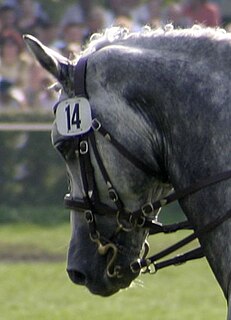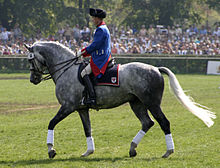
A neck rein is a type of indirect rein aid. The horse responds to a neck rein when it has learned that a light pressure of the right rein against its neck on that side means for the horse to turn left, and vice versa.
Equitation is the art or practice of horse riding or horsemanship.

Western Pleasure is a western style competition at horse shows that evaluates horses on manners and suitability of the horse for a relaxed but collected gait cadence and relatively slow speed of gait, along with calm and responsive disposition. The horse is to appear to be a "pleasure" to ride and very comfortable, while being very smooth. Most light horse breeds in the United States and Canada may compete in western pleasure classes, either in open competition or at shows limited to a single breed. However, horse conformation and temperament play a role in this event, and hence animals that are calm, quiet, have collected, soft gaits and the strong muscling required to sustain slow, controlled movement are the most competitive.

Longeing or lungeing is a technique for training horses, where a horse is asked to work at the end of a lunge line and respond to commands from a handler on the ground who holds the line. It is also a critical component of the sport of equestrian vaulting. Longeing is performed in a large circle with the horse traveling around the outside edge of a real or imaginary ring with the trainer in the middle.

A double bridle, also called a full bridle or Weymouth bridle, is a bridle that has two bits and four reins. One bit is the bradoon, is a modified snaffle bit that is smaller in diameter and has smaller bit rings than a traditional snaffle, and it is adjusted so that it sits above and behind the other bit, a curb bit. Another term for this combination of curb and snaffle bit is a "bit and bradoon", where the word "bit" in this particular context refers to the curb.

Side reins are equipment used when longeing a horse, running from the bit of the bridle to the saddle or surcingle. As a horse training tool, they encourage flexion and softness in the horse's mouth. For longe line work with a rider up who does not carry ordinary riding reins, they help calm and settle the animal. However, they are a tool best used by experienced handlers; used improperly they may unduly restrict the horse's movement or cause an accident.
Turn on the forehand is a lateral movement in equestrian schooling that involves moving the horse's hindquarters around his front legs. Although a basic movement, it is an important training tool for both horse and rider.

Rollkur or hyperflexion of the horse's neck is an illegal practice in equestrianism defined as "flexion of the horse's neck achieved through aggressive force" and is banned by the world governing body, the International Federation for Equestrian Sports (FEI). The FEI recognises a distinction between rollkur and the riding of the horse in a deep outline not achieved by force.

A bearing rein, known today as an overcheck or a checkrein, is a piece of horse tack that runs from a point on the horse's back, over the head, to a bit. It is used to prevent the horse from lowering its head beyond a fixed point. A variation called a side check passes beside the ears through loops at the top of the bridle cheekpieces.

Draw reins and running reins are pieces of riding equipment used for training that use the mechanical advantage of a 'single movable pulley' to cause the horse to bring its head down and inward. While a regular rein is the strap that attaches to the bit and is held by the rider, these types of reins slide through the bit ring, adding leverage to the rider's hands and arms, allowing the rider to force the horse's head into a desired position.
A "baucher" is also a type of bit, named after the man.

Western riding is a style of horse riding which evolved from the ranching and warfare traditions brought to the Americas by the Spanish Conquistadors, and both equipment and riding style evolved to meet the working needs of the cowboy in the American West. American cowboys needed to work long hours in the saddle over rough terrain, sometimes needing to rope cattle with a lariat. Because of the necessity to control the horse with one hand and use a lariat with the other, western horses were trained to neck rein, that is, to change direction with light pressure of a rein against the horse's neck. Horses were also trained to exercise a certain degree of independence in using their natural instincts to follow the movements of a cow, thus a riding style developed that emphasized a deep, secure seat, and training methods encouraged a horse to be responsive on very light rein contact.
Lateral movements or lateral flexions within equestrianism, have a specific meaning, used to refer to movements made by a horse where the animal is moving in a direction other than straight forward. They are used both in training and in competition, vary in difficulty, and are used in a progressive manner, according to the training and physical limitations of the animal.

Haunches-in, also called travers or tête au mur, is a lateral movement used in the dressage discipline of horse training. It has a close cousin, haunches-out, renvers, or croupe au mur, that is slightly more difficult. Both movements are four-track, meaning they produce four lines of hoof prints in the sand, as opposed to the usual two seen if the horse is straight and to the three-track shoulder-in.
The term forehand refers to the front half of a horse's body.
The half-halt is a specific riding aid given by an equestrian to his horse, in which the driving aids and restraining aids are applied in quick succession. It is sometimes thought of as an "almost halt," asking the horse to prepare to halt in balance, before pushing it onward to continue in its gait.

















